Law Taxation Report: Taxation of Fringe Benefits and Car Expenses
VerifiedAdded on 2020/04/07
|9
|1446
|44
Report
AI Summary
This law taxation report examines the tax implications of fringe benefits, particularly concerning car usage provided by Shine Homes Pty Ltd to its real estate agent, Charlie. The report delves into relevant sections of the Miscellaneous Taxation Rulings and Fringe Benefit Tax Assessment Act 1986, as well as the Income Tax Assessment Act 1997, to determine tax liabilities and allowable deductions. It analyzes the business use of the car, considering factors like travel distance, and whether the car's use is connected to the employee's assessable income. The report also addresses car parking fringe benefits and accommodation expenses, concluding with an overview of the fringe benefit expenditures and their tax implications for both the employee and the employer. The report references several legal cases and taxation rulings to support its analysis and conclusions.
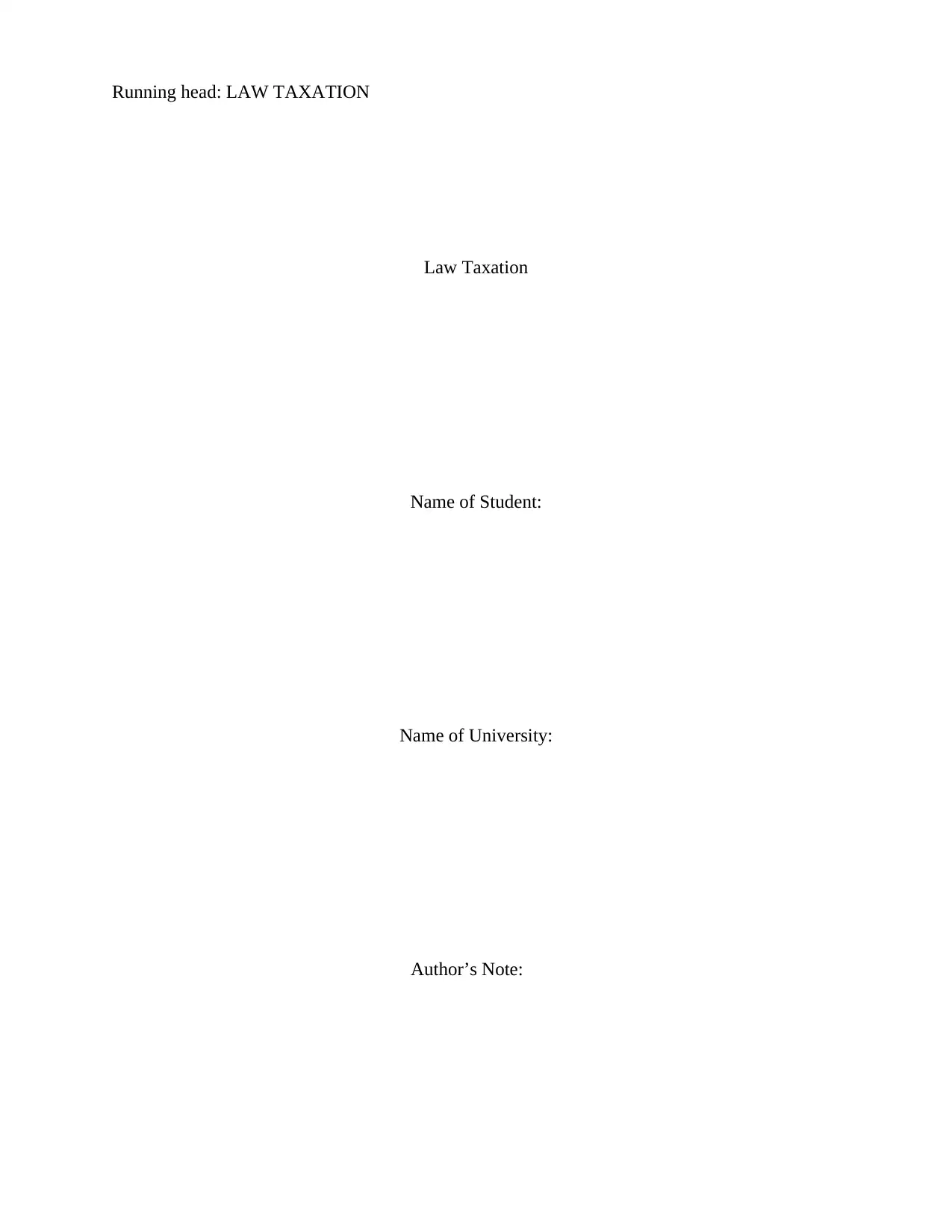
Running head: LAW TAXATION
Law Taxation
Name of Student:
Name of University:
Author’s Note:
Law Taxation
Name of Student:
Name of University:
Author’s Note:
Paraphrase This Document
Need a fresh take? Get an instant paraphrase of this document with our AI Paraphraser
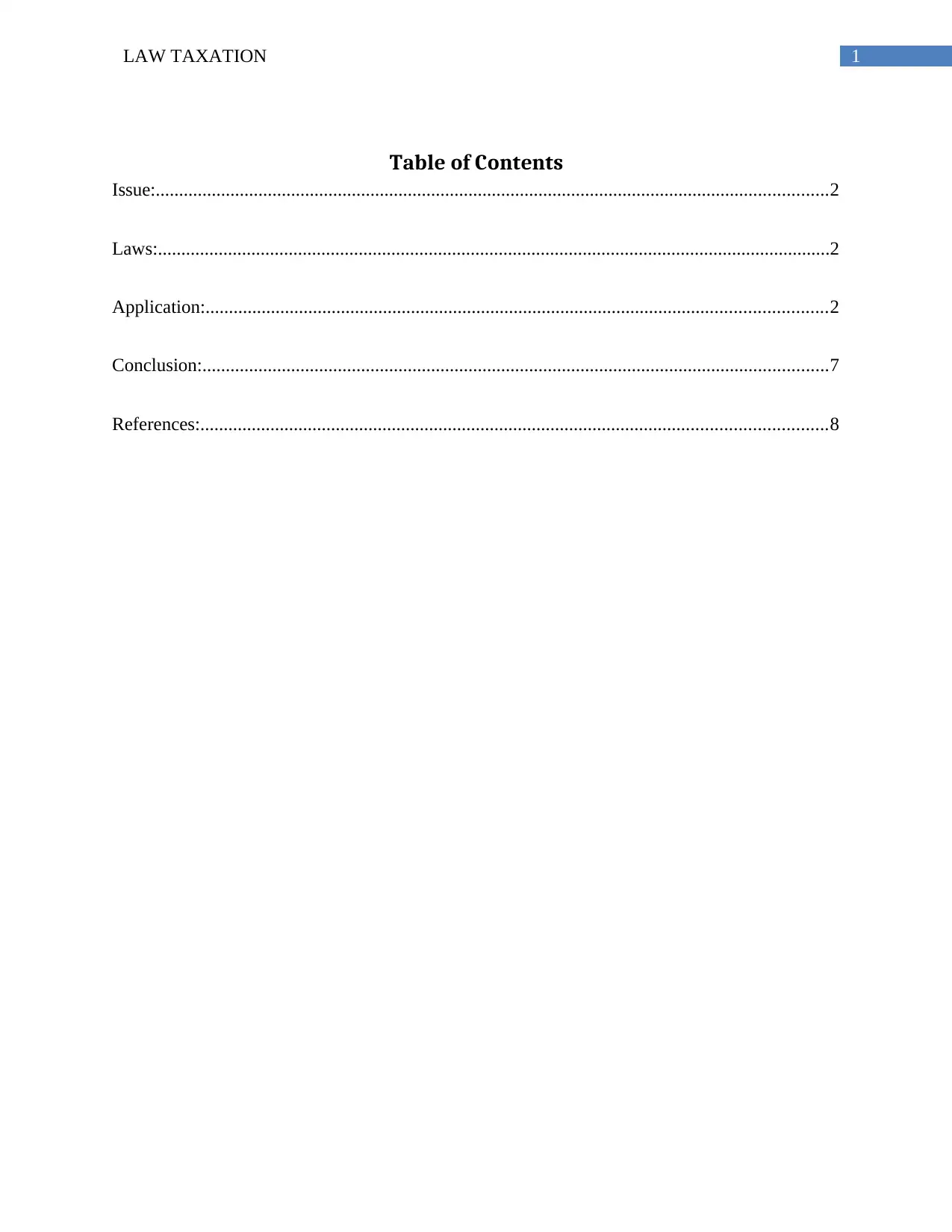
1LAW TAXATION
Table of Contents
Issue:................................................................................................................................................2
Laws:................................................................................................................................................2
Application:.....................................................................................................................................2
Conclusion:......................................................................................................................................7
References:......................................................................................................................................8
Table of Contents
Issue:................................................................................................................................................2
Laws:................................................................................................................................................2
Application:.....................................................................................................................................2
Conclusion:......................................................................................................................................7
References:......................................................................................................................................8
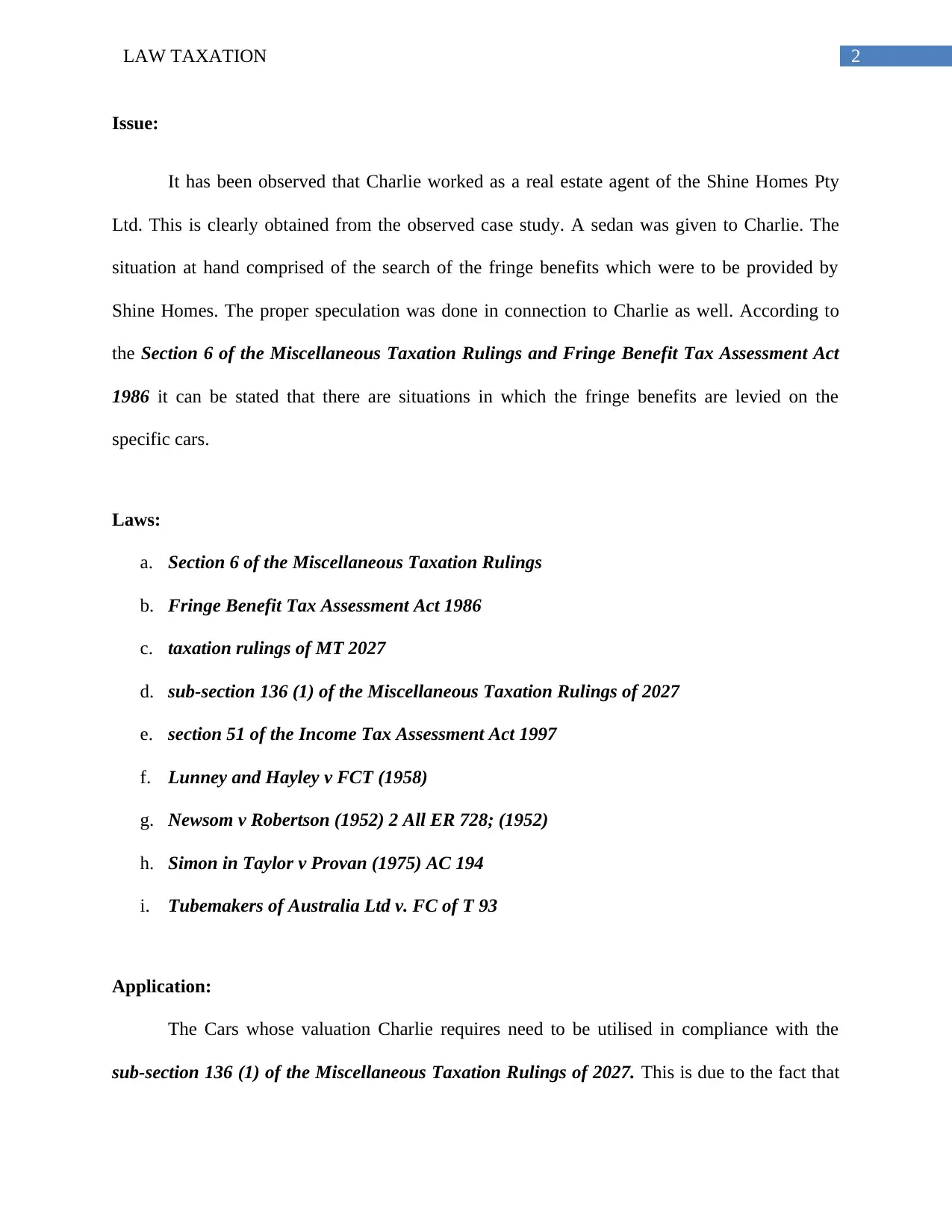
2LAW TAXATION
Issue:
It has been observed that Charlie worked as a real estate agent of the Shine Homes Pty
Ltd. This is clearly obtained from the observed case study. A sedan was given to Charlie. The
situation at hand comprised of the search of the fringe benefits which were to be provided by
Shine Homes. The proper speculation was done in connection to Charlie as well. According to
the Section 6 of the Miscellaneous Taxation Rulings and Fringe Benefit Tax Assessment Act
1986 it can be stated that there are situations in which the fringe benefits are levied on the
specific cars.
Laws:
a. Section 6 of the Miscellaneous Taxation Rulings
b. Fringe Benefit Tax Assessment Act 1986
c. taxation rulings of MT 2027
d. sub-section 136 (1) of the Miscellaneous Taxation Rulings of 2027
e. section 51 of the Income Tax Assessment Act 1997
f. Lunney and Hayley v FCT (1958)
g. Newsom v Robertson (1952) 2 All ER 728; (1952)
h. Simon in Taylor v Provan (1975) AC 194
i. Tubemakers of Australia Ltd v. FC of T 93
Application:
The Cars whose valuation Charlie requires need to be utilised in compliance with the
sub-section 136 (1) of the Miscellaneous Taxation Rulings of 2027. This is due to the fact that
Issue:
It has been observed that Charlie worked as a real estate agent of the Shine Homes Pty
Ltd. This is clearly obtained from the observed case study. A sedan was given to Charlie. The
situation at hand comprised of the search of the fringe benefits which were to be provided by
Shine Homes. The proper speculation was done in connection to Charlie as well. According to
the Section 6 of the Miscellaneous Taxation Rulings and Fringe Benefit Tax Assessment Act
1986 it can be stated that there are situations in which the fringe benefits are levied on the
specific cars.
Laws:
a. Section 6 of the Miscellaneous Taxation Rulings
b. Fringe Benefit Tax Assessment Act 1986
c. taxation rulings of MT 2027
d. sub-section 136 (1) of the Miscellaneous Taxation Rulings of 2027
e. section 51 of the Income Tax Assessment Act 1997
f. Lunney and Hayley v FCT (1958)
g. Newsom v Robertson (1952) 2 All ER 728; (1952)
h. Simon in Taylor v Provan (1975) AC 194
i. Tubemakers of Australia Ltd v. FC of T 93
Application:
The Cars whose valuation Charlie requires need to be utilised in compliance with the
sub-section 136 (1) of the Miscellaneous Taxation Rulings of 2027. This is due to the fact that
⊘ This is a preview!⊘
Do you want full access?
Subscribe today to unlock all pages.

Trusted by 1+ million students worldwide
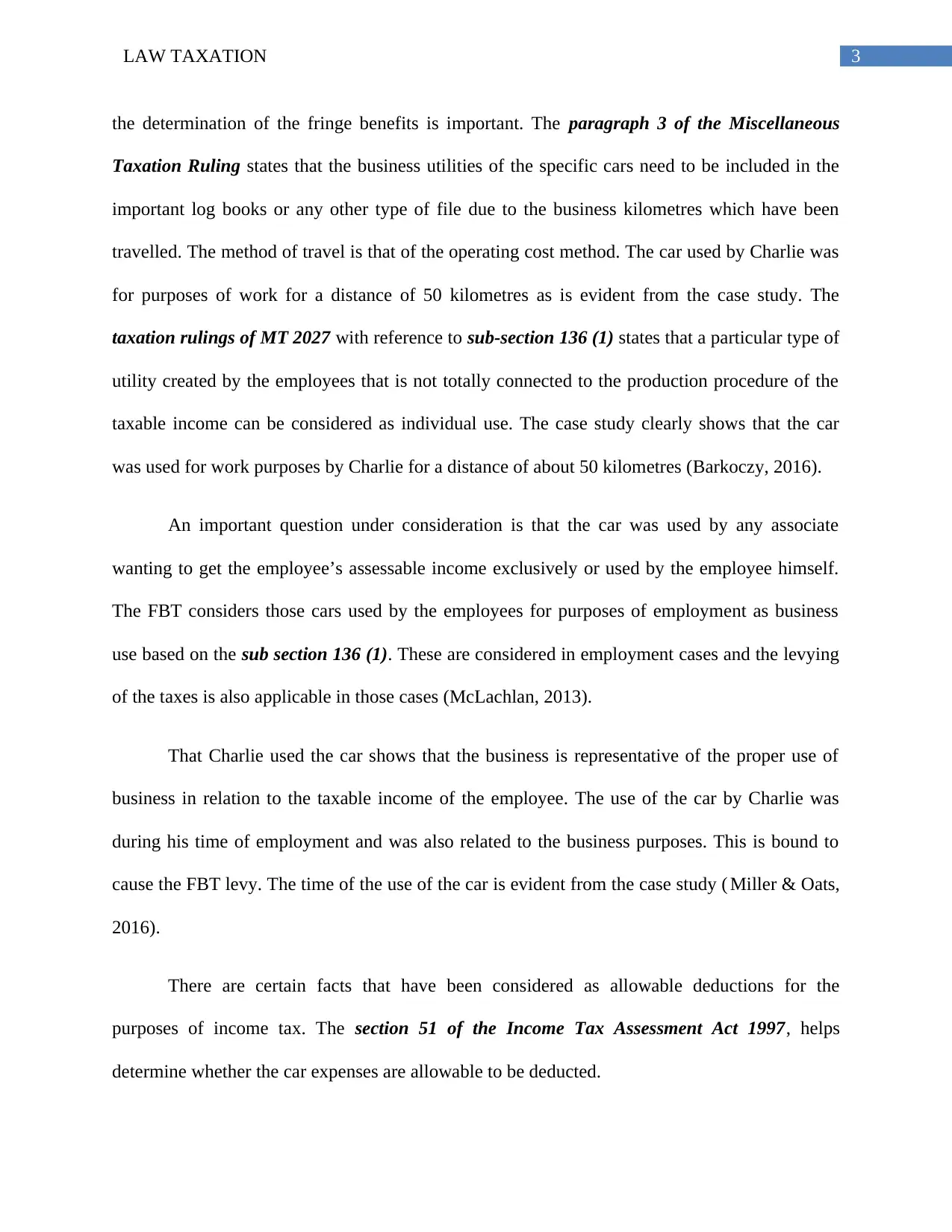
3LAW TAXATION
the determination of the fringe benefits is important. The paragraph 3 of the Miscellaneous
Taxation Ruling states that the business utilities of the specific cars need to be included in the
important log books or any other type of file due to the business kilometres which have been
travelled. The method of travel is that of the operating cost method. The car used by Charlie was
for purposes of work for a distance of 50 kilometres as is evident from the case study. The
taxation rulings of MT 2027 with reference to sub-section 136 (1) states that a particular type of
utility created by the employees that is not totally connected to the production procedure of the
taxable income can be considered as individual use. The case study clearly shows that the car
was used for work purposes by Charlie for a distance of about 50 kilometres (Barkoczy, 2016).
An important question under consideration is that the car was used by any associate
wanting to get the employee’s assessable income exclusively or used by the employee himself.
The FBT considers those cars used by the employees for purposes of employment as business
use based on the sub section 136 (1). These are considered in employment cases and the levying
of the taxes is also applicable in those cases (McLachlan, 2013).
That Charlie used the car shows that the business is representative of the proper use of
business in relation to the taxable income of the employee. The use of the car by Charlie was
during his time of employment and was also related to the business purposes. This is bound to
cause the FBT levy. The time of the use of the car is evident from the case study ( Miller & Oats,
2016).
There are certain facts that have been considered as allowable deductions for the
purposes of income tax. The section 51 of the Income Tax Assessment Act 1997, helps
determine whether the car expenses are allowable to be deducted.
the determination of the fringe benefits is important. The paragraph 3 of the Miscellaneous
Taxation Ruling states that the business utilities of the specific cars need to be included in the
important log books or any other type of file due to the business kilometres which have been
travelled. The method of travel is that of the operating cost method. The car used by Charlie was
for purposes of work for a distance of 50 kilometres as is evident from the case study. The
taxation rulings of MT 2027 with reference to sub-section 136 (1) states that a particular type of
utility created by the employees that is not totally connected to the production procedure of the
taxable income can be considered as individual use. The case study clearly shows that the car
was used for work purposes by Charlie for a distance of about 50 kilometres (Barkoczy, 2016).
An important question under consideration is that the car was used by any associate
wanting to get the employee’s assessable income exclusively or used by the employee himself.
The FBT considers those cars used by the employees for purposes of employment as business
use based on the sub section 136 (1). These are considered in employment cases and the levying
of the taxes is also applicable in those cases (McLachlan, 2013).
That Charlie used the car shows that the business is representative of the proper use of
business in relation to the taxable income of the employee. The use of the car by Charlie was
during his time of employment and was also related to the business purposes. This is bound to
cause the FBT levy. The time of the use of the car is evident from the case study ( Miller & Oats,
2016).
There are certain facts that have been considered as allowable deductions for the
purposes of income tax. The section 51 of the Income Tax Assessment Act 1997, helps
determine whether the car expenses are allowable to be deducted.
Paraphrase This Document
Need a fresh take? Get an instant paraphrase of this document with our AI Paraphraser
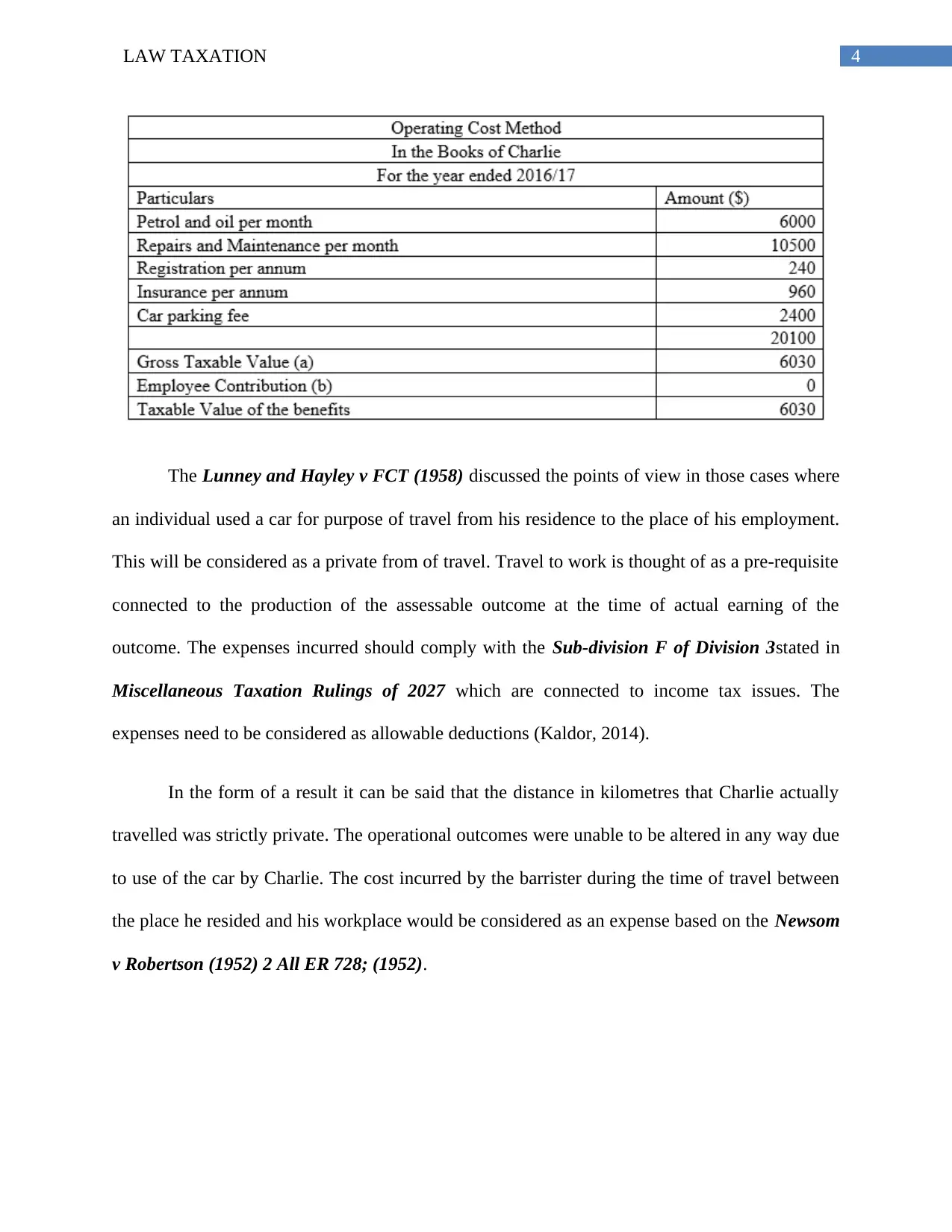
4LAW TAXATION
The Lunney and Hayley v FCT (1958) discussed the points of view in those cases where
an individual used a car for purpose of travel from his residence to the place of his employment.
This will be considered as a private from of travel. Travel to work is thought of as a pre-requisite
connected to the production of the assessable outcome at the time of actual earning of the
outcome. The expenses incurred should comply with the Sub-division F of Division 3stated in
Miscellaneous Taxation Rulings of 2027 which are connected to income tax issues. The
expenses need to be considered as allowable deductions (Kaldor, 2014).
In the form of a result it can be said that the distance in kilometres that Charlie actually
travelled was strictly private. The operational outcomes were unable to be altered in any way due
to use of the car by Charlie. The cost incurred by the barrister during the time of travel between
the place he resided and his workplace would be considered as an expense based on the Newsom
v Robertson (1952) 2 All ER 728; (1952).
The Lunney and Hayley v FCT (1958) discussed the points of view in those cases where
an individual used a car for purpose of travel from his residence to the place of his employment.
This will be considered as a private from of travel. Travel to work is thought of as a pre-requisite
connected to the production of the assessable outcome at the time of actual earning of the
outcome. The expenses incurred should comply with the Sub-division F of Division 3stated in
Miscellaneous Taxation Rulings of 2027 which are connected to income tax issues. The
expenses need to be considered as allowable deductions (Kaldor, 2014).
In the form of a result it can be said that the distance in kilometres that Charlie actually
travelled was strictly private. The operational outcomes were unable to be altered in any way due
to use of the car by Charlie. The cost incurred by the barrister during the time of travel between
the place he resided and his workplace would be considered as an expense based on the Newsom
v Robertson (1952) 2 All ER 728; (1952).
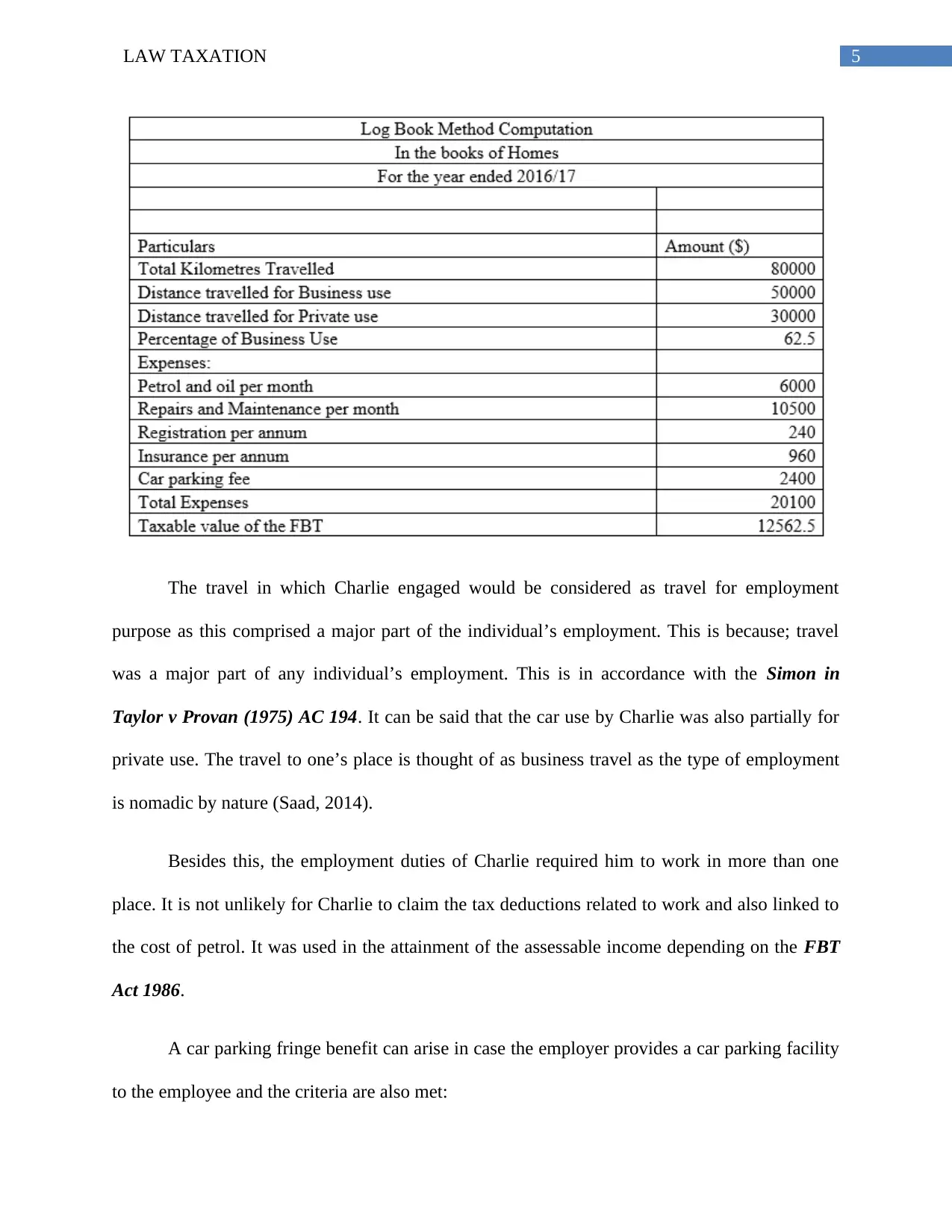
5LAW TAXATION
The travel in which Charlie engaged would be considered as travel for employment
purpose as this comprised a major part of the individual’s employment. This is because; travel
was a major part of any individual’s employment. This is in accordance with the Simon in
Taylor v Provan (1975) AC 194. It can be said that the car use by Charlie was also partially for
private use. The travel to one’s place is thought of as business travel as the type of employment
is nomadic by nature (Saad, 2014).
Besides this, the employment duties of Charlie required him to work in more than one
place. It is not unlikely for Charlie to claim the tax deductions related to work and also linked to
the cost of petrol. It was used in the attainment of the assessable income depending on the FBT
Act 1986.
A car parking fringe benefit can arise in case the employer provides a car parking facility
to the employee and the criteria are also met:
The travel in which Charlie engaged would be considered as travel for employment
purpose as this comprised a major part of the individual’s employment. This is because; travel
was a major part of any individual’s employment. This is in accordance with the Simon in
Taylor v Provan (1975) AC 194. It can be said that the car use by Charlie was also partially for
private use. The travel to one’s place is thought of as business travel as the type of employment
is nomadic by nature (Saad, 2014).
Besides this, the employment duties of Charlie required him to work in more than one
place. It is not unlikely for Charlie to claim the tax deductions related to work and also linked to
the cost of petrol. It was used in the attainment of the assessable income depending on the FBT
Act 1986.
A car parking fringe benefit can arise in case the employer provides a car parking facility
to the employee and the criteria are also met:
⊘ This is a preview!⊘
Do you want full access?
Subscribe today to unlock all pages.

Trusted by 1+ million students worldwide
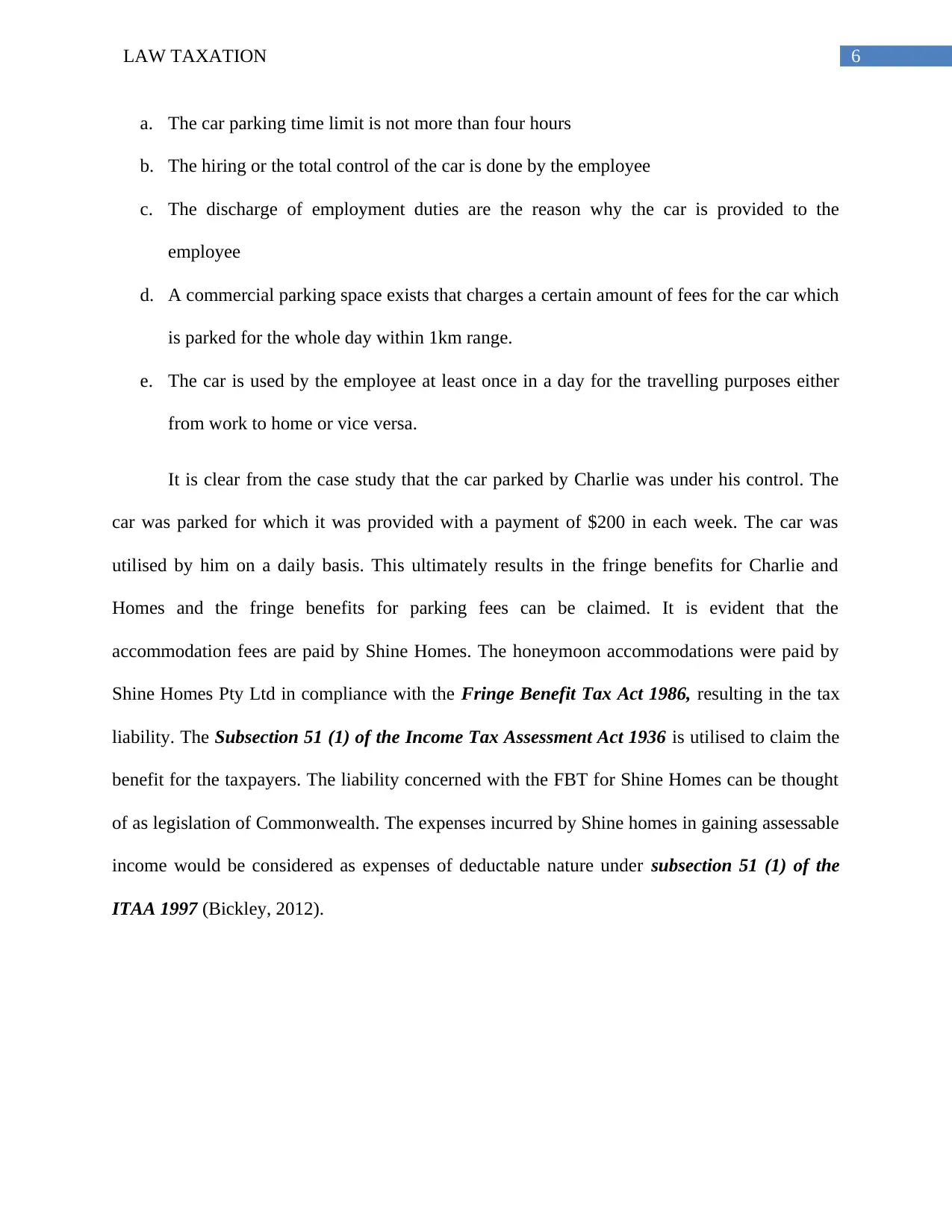
6LAW TAXATION
a. The car parking time limit is not more than four hours
b. The hiring or the total control of the car is done by the employee
c. The discharge of employment duties are the reason why the car is provided to the
employee
d. A commercial parking space exists that charges a certain amount of fees for the car which
is parked for the whole day within 1km range.
e. The car is used by the employee at least once in a day for the travelling purposes either
from work to home or vice versa.
It is clear from the case study that the car parked by Charlie was under his control. The
car was parked for which it was provided with a payment of $200 in each week. The car was
utilised by him on a daily basis. This ultimately results in the fringe benefits for Charlie and
Homes and the fringe benefits for parking fees can be claimed. It is evident that the
accommodation fees are paid by Shine Homes. The honeymoon accommodations were paid by
Shine Homes Pty Ltd in compliance with the Fringe Benefit Tax Act 1986, resulting in the tax
liability. The Subsection 51 (1) of the Income Tax Assessment Act 1936 is utilised to claim the
benefit for the taxpayers. The liability concerned with the FBT for Shine Homes can be thought
of as legislation of Commonwealth. The expenses incurred by Shine homes in gaining assessable
income would be considered as expenses of deductable nature under subsection 51 (1) of the
ITAA 1997 (Bickley, 2012).
a. The car parking time limit is not more than four hours
b. The hiring or the total control of the car is done by the employee
c. The discharge of employment duties are the reason why the car is provided to the
employee
d. A commercial parking space exists that charges a certain amount of fees for the car which
is parked for the whole day within 1km range.
e. The car is used by the employee at least once in a day for the travelling purposes either
from work to home or vice versa.
It is clear from the case study that the car parked by Charlie was under his control. The
car was parked for which it was provided with a payment of $200 in each week. The car was
utilised by him on a daily basis. This ultimately results in the fringe benefits for Charlie and
Homes and the fringe benefits for parking fees can be claimed. It is evident that the
accommodation fees are paid by Shine Homes. The honeymoon accommodations were paid by
Shine Homes Pty Ltd in compliance with the Fringe Benefit Tax Act 1986, resulting in the tax
liability. The Subsection 51 (1) of the Income Tax Assessment Act 1936 is utilised to claim the
benefit for the taxpayers. The liability concerned with the FBT for Shine Homes can be thought
of as legislation of Commonwealth. The expenses incurred by Shine homes in gaining assessable
income would be considered as expenses of deductable nature under subsection 51 (1) of the
ITAA 1997 (Bickley, 2012).
Paraphrase This Document
Need a fresh take? Get an instant paraphrase of this document with our AI Paraphraser
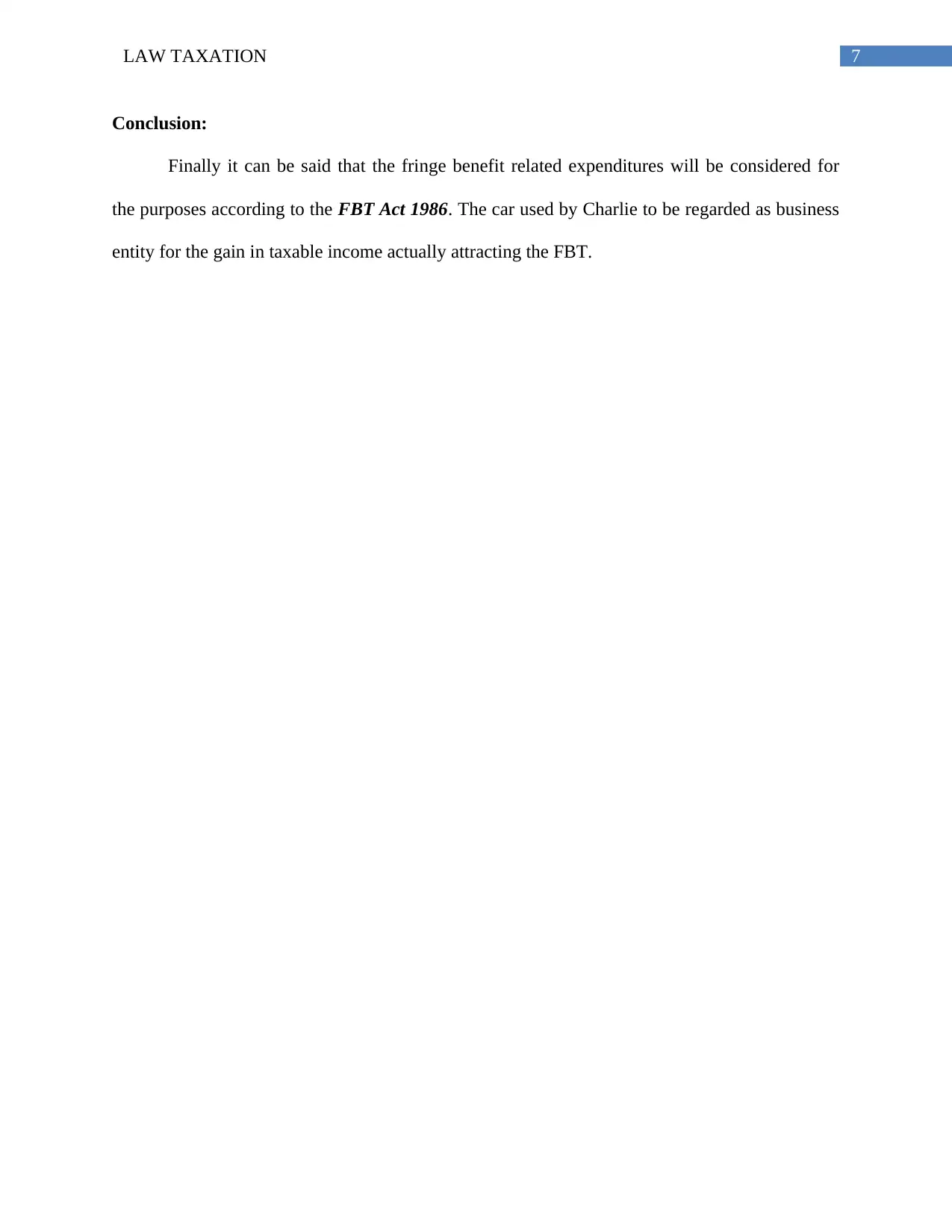
7LAW TAXATION
Conclusion:
Finally it can be said that the fringe benefit related expenditures will be considered for
the purposes according to the FBT Act 1986. The car used by Charlie to be regarded as business
entity for the gain in taxable income actually attracting the FBT.
Conclusion:
Finally it can be said that the fringe benefit related expenditures will be considered for
the purposes according to the FBT Act 1986. The car used by Charlie to be regarded as business
entity for the gain in taxable income actually attracting the FBT.
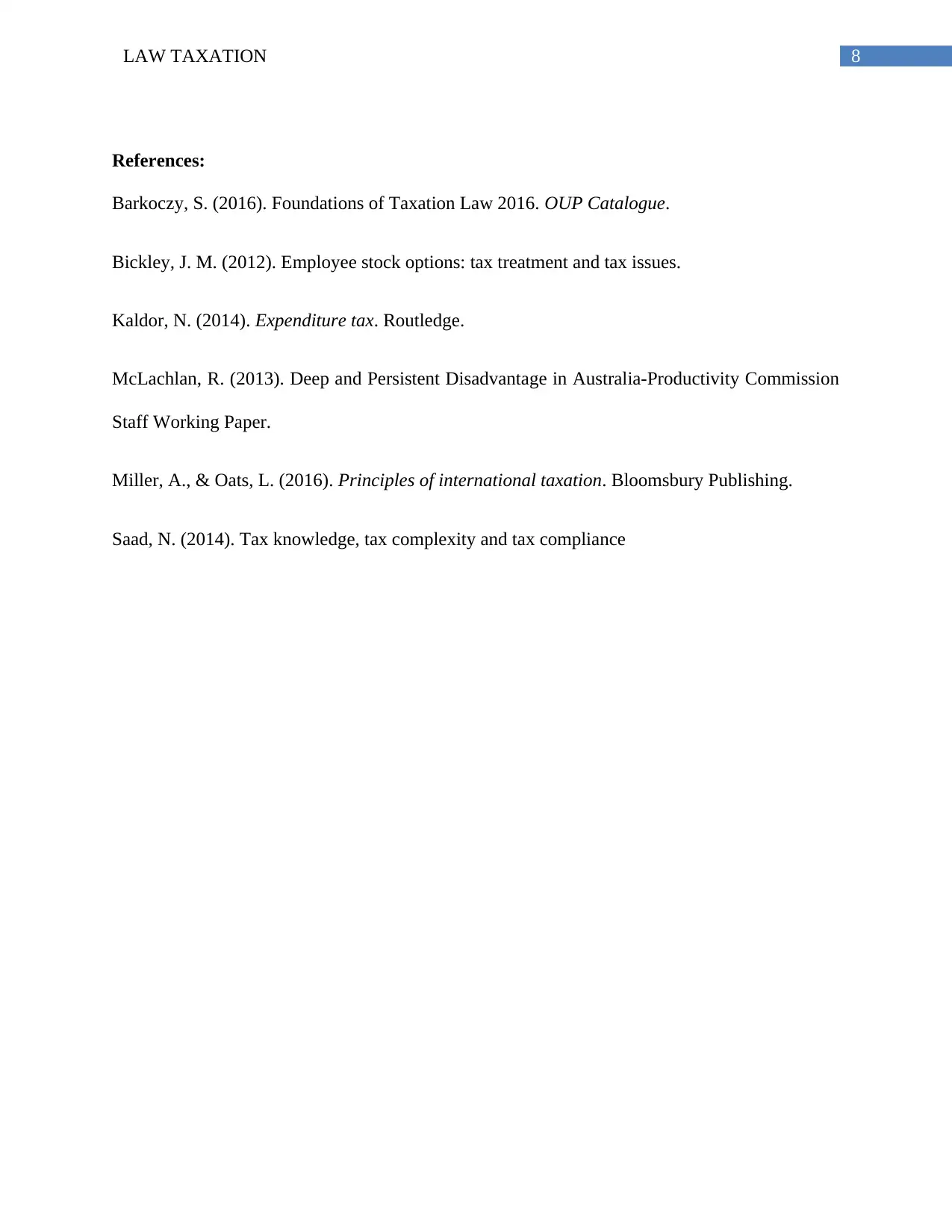
8LAW TAXATION
References:
Barkoczy, S. (2016). Foundations of Taxation Law 2016. OUP Catalogue.
Bickley, J. M. (2012). Employee stock options: tax treatment and tax issues.
Kaldor, N. (2014). Expenditure tax. Routledge.
McLachlan, R. (2013). Deep and Persistent Disadvantage in Australia-Productivity Commission
Staff Working Paper.
Miller, A., & Oats, L. (2016). Principles of international taxation. Bloomsbury Publishing.
Saad, N. (2014). Tax knowledge, tax complexity and tax compliance
References:
Barkoczy, S. (2016). Foundations of Taxation Law 2016. OUP Catalogue.
Bickley, J. M. (2012). Employee stock options: tax treatment and tax issues.
Kaldor, N. (2014). Expenditure tax. Routledge.
McLachlan, R. (2013). Deep and Persistent Disadvantage in Australia-Productivity Commission
Staff Working Paper.
Miller, A., & Oats, L. (2016). Principles of international taxation. Bloomsbury Publishing.
Saad, N. (2014). Tax knowledge, tax complexity and tax compliance
⊘ This is a preview!⊘
Do you want full access?
Subscribe today to unlock all pages.

Trusted by 1+ million students worldwide
1 out of 9
Related Documents
Your All-in-One AI-Powered Toolkit for Academic Success.
+13062052269
info@desklib.com
Available 24*7 on WhatsApp / Email
![[object Object]](/_next/static/media/star-bottom.7253800d.svg)
Unlock your academic potential
Copyright © 2020–2025 A2Z Services. All Rights Reserved. Developed and managed by ZUCOL.





